Leadership and Management: Tesco CEO's Organisational Analysis Report
VerifiedAdded on 2022/12/28
|13
|4275
|82
Report
AI Summary
This report provides an in-depth analysis of the leadership and management practices of Tesco's CEO. It begins by examining the CEO's management style, principles, and functions, focusing on how the CEO approaches planning, organizing, staffing, directing, and controlling within the organization. The report then delves into the steps taken by the CEO to change the organizational structure to enhance performance, discussing the impact on employees and organizational culture. Further, it describes the CEO's leadership style, highlighting its role in improving organizational effectiveness. The report also analyzes the effects of power, influence, and conflict within the organization, discussing the various types of motivation used by the firm and supporting the analysis with corporate examples and literature. Finally, it offers suggestions and recommendations to enhance organizational performance, concluding with a summary of the key findings and insights.
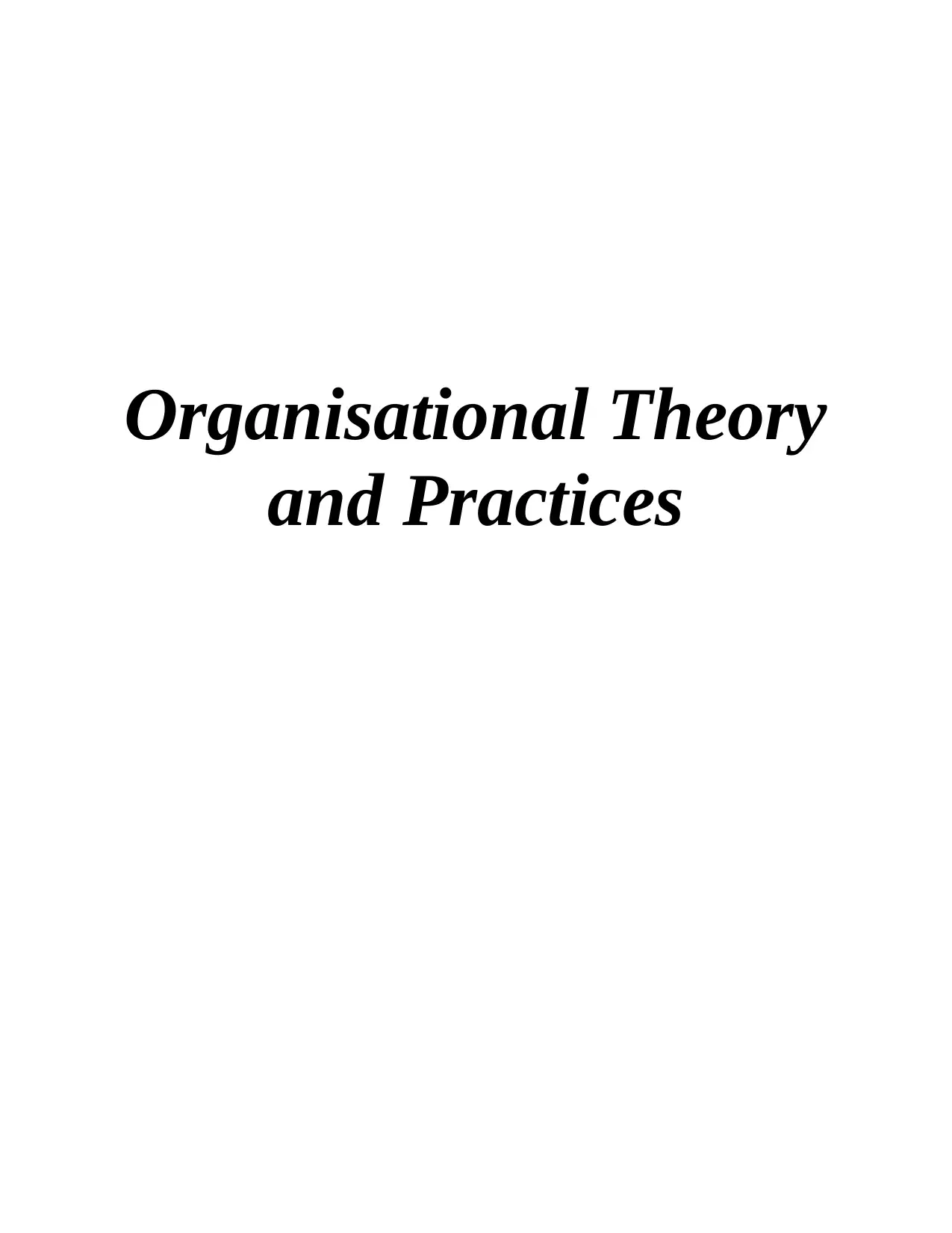
Organisational Theory
and Practices
and Practices
Paraphrase This Document
Need a fresh take? Get an instant paraphrase of this document with our AI Paraphraser
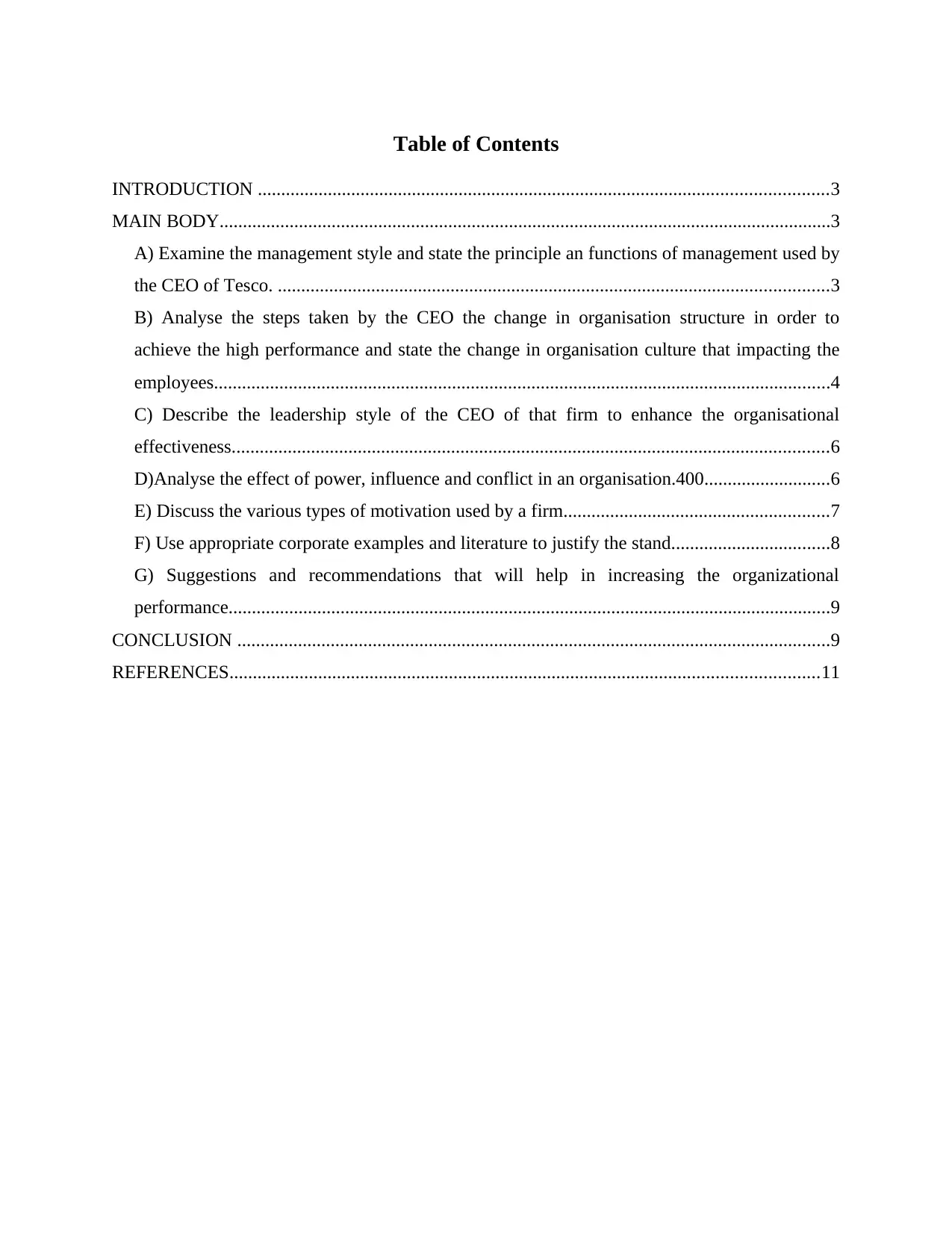
Table of Contents
INTRODUCTION ..........................................................................................................................3
MAIN BODY...................................................................................................................................3
A) Examine the management style and state the principle an functions of management used by
the CEO of Tesco. ......................................................................................................................3
B) Analyse the steps taken by the CEO the change in organisation structure in order to
achieve the high performance and state the change in organisation culture that impacting the
employees....................................................................................................................................4
C) Describe the leadership style of the CEO of that firm to enhance the organisational
effectiveness................................................................................................................................6
D)Analyse the effect of power, influence and conflict in an organisation.400...........................6
E) Discuss the various types of motivation used by a firm.........................................................7
F) Use appropriate corporate examples and literature to justify the stand..................................8
G) Suggestions and recommendations that will help in increasing the organizational
performance.................................................................................................................................9
CONCLUSION ...............................................................................................................................9
REFERENCES..............................................................................................................................11
INTRODUCTION ..........................................................................................................................3
MAIN BODY...................................................................................................................................3
A) Examine the management style and state the principle an functions of management used by
the CEO of Tesco. ......................................................................................................................3
B) Analyse the steps taken by the CEO the change in organisation structure in order to
achieve the high performance and state the change in organisation culture that impacting the
employees....................................................................................................................................4
C) Describe the leadership style of the CEO of that firm to enhance the organisational
effectiveness................................................................................................................................6
D)Analyse the effect of power, influence and conflict in an organisation.400...........................6
E) Discuss the various types of motivation used by a firm.........................................................7
F) Use appropriate corporate examples and literature to justify the stand..................................8
G) Suggestions and recommendations that will help in increasing the organizational
performance.................................................................................................................................9
CONCLUSION ...............................................................................................................................9
REFERENCES..............................................................................................................................11
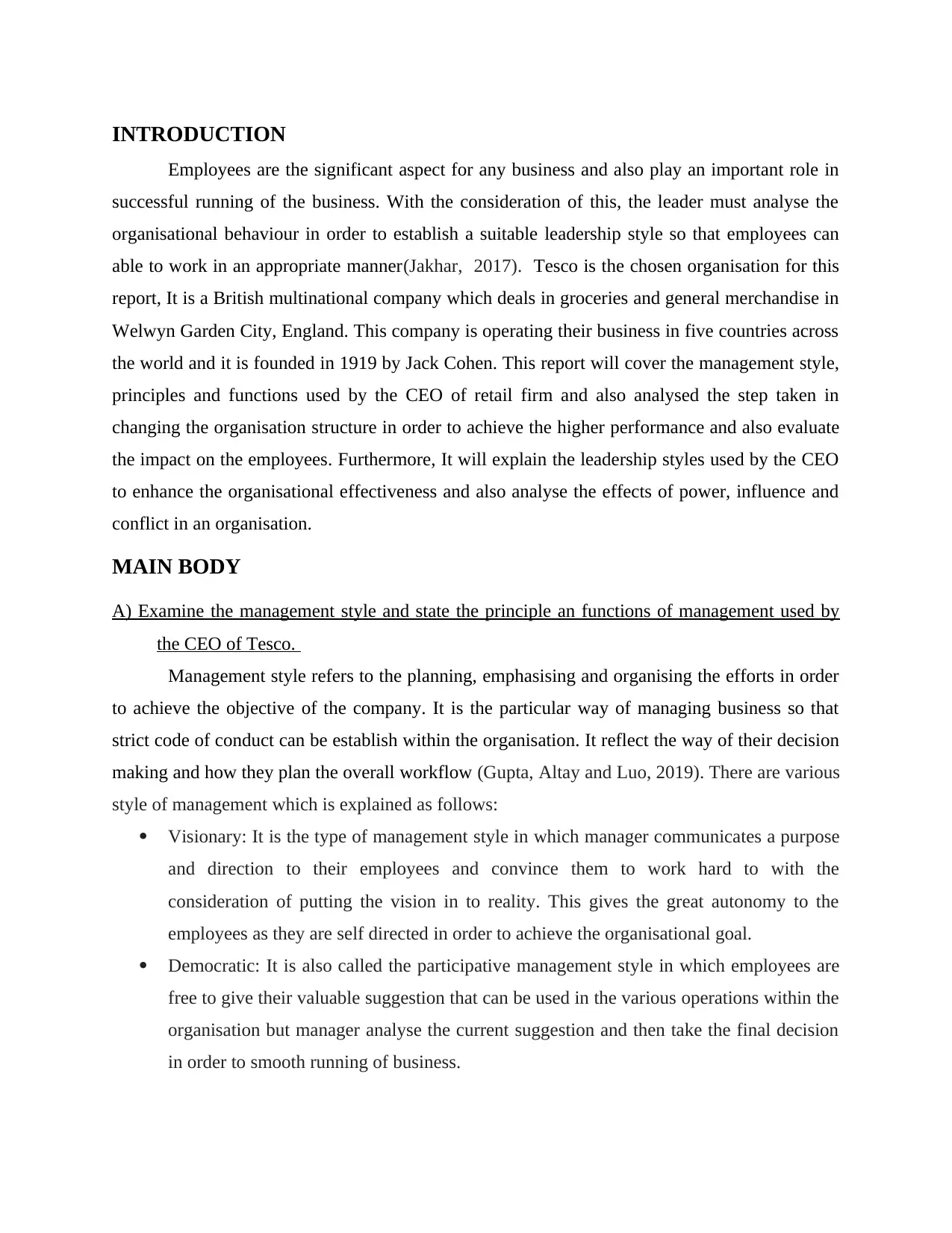
INTRODUCTION
Employees are the significant aspect for any business and also play an important role in
successful running of the business. With the consideration of this, the leader must analyse the
organisational behaviour in order to establish a suitable leadership style so that employees can
able to work in an appropriate manner(Jakhar, 2017). Tesco is the chosen organisation for this
report, It is a British multinational company which deals in groceries and general merchandise in
Welwyn Garden City, England. This company is operating their business in five countries across
the world and it is founded in 1919 by Jack Cohen. This report will cover the management style,
principles and functions used by the CEO of retail firm and also analysed the step taken in
changing the organisation structure in order to achieve the higher performance and also evaluate
the impact on the employees. Furthermore, It will explain the leadership styles used by the CEO
to enhance the organisational effectiveness and also analyse the effects of power, influence and
conflict in an organisation.
MAIN BODY
A) Examine the management style and state the principle an functions of management used by
the CEO of Tesco.
Management style refers to the planning, emphasising and organising the efforts in order
to achieve the objective of the company. It is the particular way of managing business so that
strict code of conduct can be establish within the organisation. It reflect the way of their decision
making and how they plan the overall workflow (Gupta, Altay and Luo, 2019). There are various
style of management which is explained as follows:
Visionary: It is the type of management style in which manager communicates a purpose
and direction to their employees and convince them to work hard to with the
consideration of putting the vision in to reality. This gives the great autonomy to the
employees as they are self directed in order to achieve the organisational goal.
Democratic: It is also called the participative management style in which employees are
free to give their valuable suggestion that can be used in the various operations within the
organisation but manager analyse the current suggestion and then take the final decision
in order to smooth running of business.
Employees are the significant aspect for any business and also play an important role in
successful running of the business. With the consideration of this, the leader must analyse the
organisational behaviour in order to establish a suitable leadership style so that employees can
able to work in an appropriate manner(Jakhar, 2017). Tesco is the chosen organisation for this
report, It is a British multinational company which deals in groceries and general merchandise in
Welwyn Garden City, England. This company is operating their business in five countries across
the world and it is founded in 1919 by Jack Cohen. This report will cover the management style,
principles and functions used by the CEO of retail firm and also analysed the step taken in
changing the organisation structure in order to achieve the higher performance and also evaluate
the impact on the employees. Furthermore, It will explain the leadership styles used by the CEO
to enhance the organisational effectiveness and also analyse the effects of power, influence and
conflict in an organisation.
MAIN BODY
A) Examine the management style and state the principle an functions of management used by
the CEO of Tesco.
Management style refers to the planning, emphasising and organising the efforts in order
to achieve the objective of the company. It is the particular way of managing business so that
strict code of conduct can be establish within the organisation. It reflect the way of their decision
making and how they plan the overall workflow (Gupta, Altay and Luo, 2019). There are various
style of management which is explained as follows:
Visionary: It is the type of management style in which manager communicates a purpose
and direction to their employees and convince them to work hard to with the
consideration of putting the vision in to reality. This gives the great autonomy to the
employees as they are self directed in order to achieve the organisational goal.
Democratic: It is also called the participative management style in which employees are
free to give their valuable suggestion that can be used in the various operations within the
organisation but manager analyse the current suggestion and then take the final decision
in order to smooth running of business.
⊘ This is a preview!⊘
Do you want full access?
Subscribe today to unlock all pages.

Trusted by 1+ million students worldwide
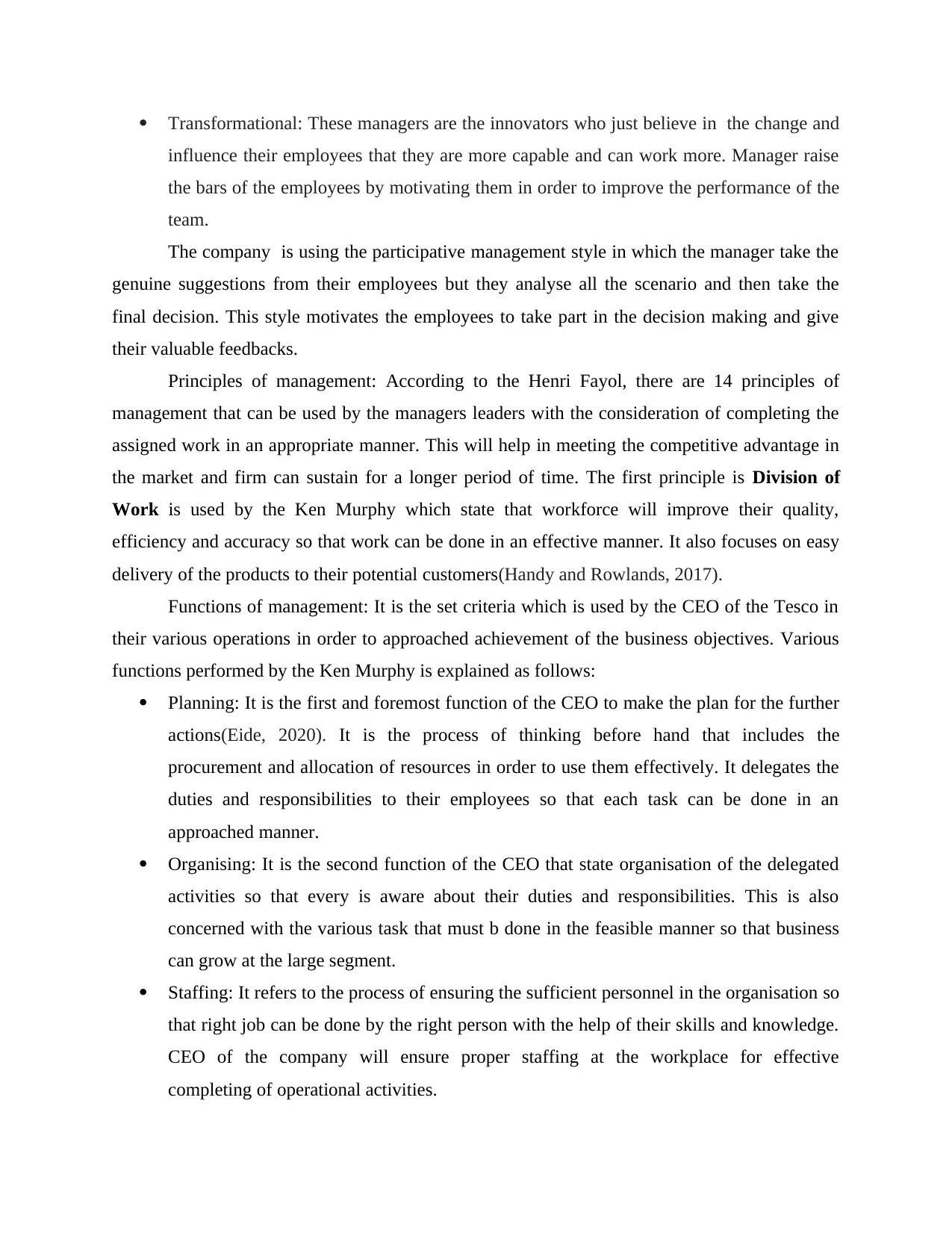
Transformational: These managers are the innovators who just believe in the change and
influence their employees that they are more capable and can work more. Manager raise
the bars of the employees by motivating them in order to improve the performance of the
team.
The company is using the participative management style in which the manager take the
genuine suggestions from their employees but they analyse all the scenario and then take the
final decision. This style motivates the employees to take part in the decision making and give
their valuable feedbacks.
Principles of management: According to the Henri Fayol, there are 14 principles of
management that can be used by the managers leaders with the consideration of completing the
assigned work in an appropriate manner. This will help in meeting the competitive advantage in
the market and firm can sustain for a longer period of time. The first principle is Division of
Work is used by the Ken Murphy which state that workforce will improve their quality,
efficiency and accuracy so that work can be done in an effective manner. It also focuses on easy
delivery of the products to their potential customers(Handy and Rowlands, 2017).
Functions of management: It is the set criteria which is used by the CEO of the Tesco in
their various operations in order to approached achievement of the business objectives. Various
functions performed by the Ken Murphy is explained as follows:
Planning: It is the first and foremost function of the CEO to make the plan for the further
actions(Eide, 2020). It is the process of thinking before hand that includes the
procurement and allocation of resources in order to use them effectively. It delegates the
duties and responsibilities to their employees so that each task can be done in an
approached manner.
Organising: It is the second function of the CEO that state organisation of the delegated
activities so that every is aware about their duties and responsibilities. This is also
concerned with the various task that must b done in the feasible manner so that business
can grow at the large segment.
Staffing: It refers to the process of ensuring the sufficient personnel in the organisation so
that right job can be done by the right person with the help of their skills and knowledge.
CEO of the company will ensure proper staffing at the workplace for effective
completing of operational activities.
influence their employees that they are more capable and can work more. Manager raise
the bars of the employees by motivating them in order to improve the performance of the
team.
The company is using the participative management style in which the manager take the
genuine suggestions from their employees but they analyse all the scenario and then take the
final decision. This style motivates the employees to take part in the decision making and give
their valuable feedbacks.
Principles of management: According to the Henri Fayol, there are 14 principles of
management that can be used by the managers leaders with the consideration of completing the
assigned work in an appropriate manner. This will help in meeting the competitive advantage in
the market and firm can sustain for a longer period of time. The first principle is Division of
Work is used by the Ken Murphy which state that workforce will improve their quality,
efficiency and accuracy so that work can be done in an effective manner. It also focuses on easy
delivery of the products to their potential customers(Handy and Rowlands, 2017).
Functions of management: It is the set criteria which is used by the CEO of the Tesco in
their various operations in order to approached achievement of the business objectives. Various
functions performed by the Ken Murphy is explained as follows:
Planning: It is the first and foremost function of the CEO to make the plan for the further
actions(Eide, 2020). It is the process of thinking before hand that includes the
procurement and allocation of resources in order to use them effectively. It delegates the
duties and responsibilities to their employees so that each task can be done in an
approached manner.
Organising: It is the second function of the CEO that state organisation of the delegated
activities so that every is aware about their duties and responsibilities. This is also
concerned with the various task that must b done in the feasible manner so that business
can grow at the large segment.
Staffing: It refers to the process of ensuring the sufficient personnel in the organisation so
that right job can be done by the right person with the help of their skills and knowledge.
CEO of the company will ensure proper staffing at the workplace for effective
completing of operational activities.
Paraphrase This Document
Need a fresh take? Get an instant paraphrase of this document with our AI Paraphraser
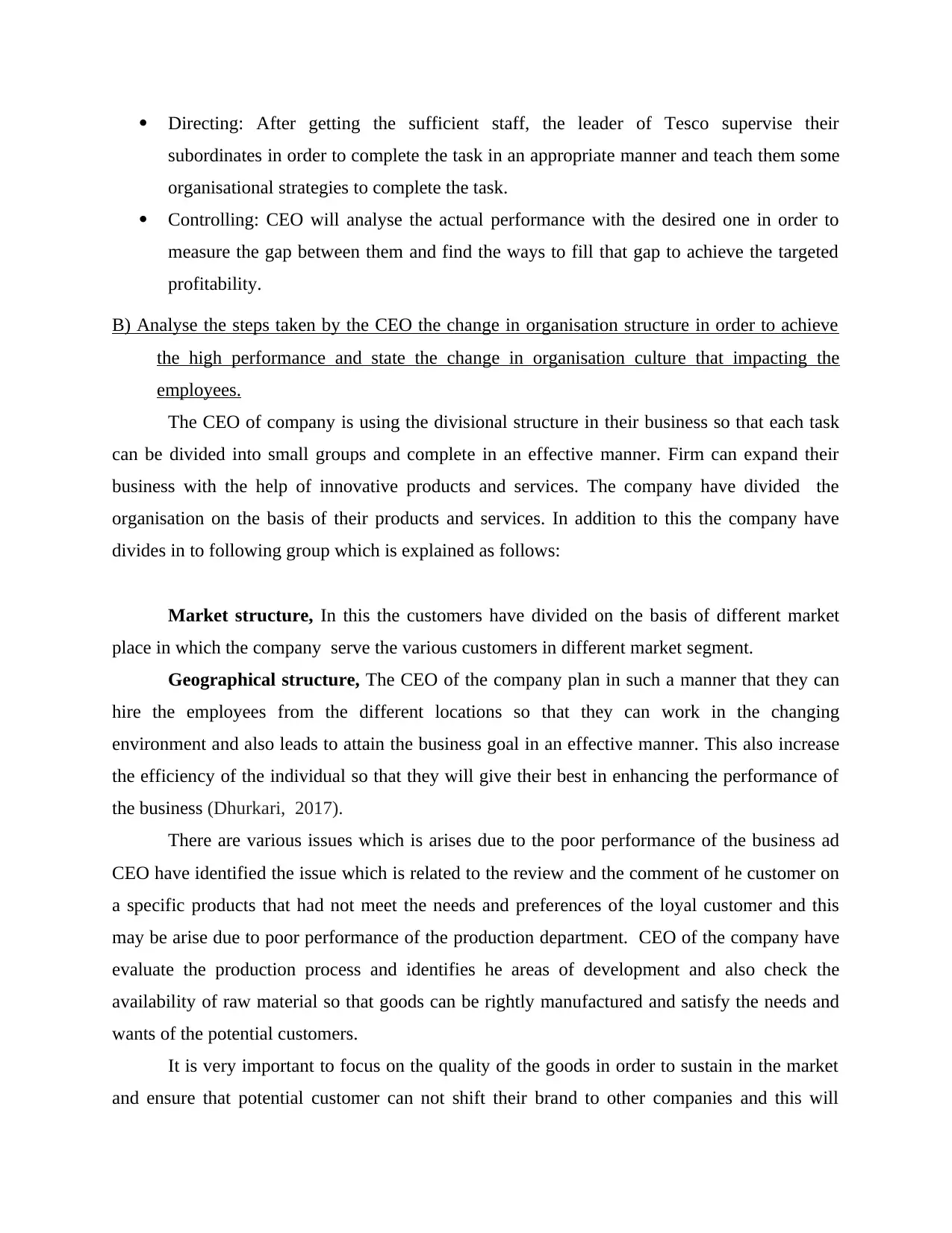
Directing: After getting the sufficient staff, the leader of Tesco supervise their
subordinates in order to complete the task in an appropriate manner and teach them some
organisational strategies to complete the task.
Controlling: CEO will analyse the actual performance with the desired one in order to
measure the gap between them and find the ways to fill that gap to achieve the targeted
profitability.
B) Analyse the steps taken by the CEO the change in organisation structure in order to achieve
the high performance and state the change in organisation culture that impacting the
employees.
The CEO of company is using the divisional structure in their business so that each task
can be divided into small groups and complete in an effective manner. Firm can expand their
business with the help of innovative products and services. The company have divided the
organisation on the basis of their products and services. In addition to this the company have
divides in to following group which is explained as follows:
Market structure, In this the customers have divided on the basis of different market
place in which the company serve the various customers in different market segment.
Geographical structure, The CEO of the company plan in such a manner that they can
hire the employees from the different locations so that they can work in the changing
environment and also leads to attain the business goal in an effective manner. This also increase
the efficiency of the individual so that they will give their best in enhancing the performance of
the business (Dhurkari, 2017).
There are various issues which is arises due to the poor performance of the business ad
CEO have identified the issue which is related to the review and the comment of he customer on
a specific products that had not meet the needs and preferences of the loyal customer and this
may be arise due to poor performance of the production department. CEO of the company have
evaluate the production process and identifies he areas of development and also check the
availability of raw material so that goods can be rightly manufactured and satisfy the needs and
wants of the potential customers.
It is very important to focus on the quality of the goods in order to sustain in the market
and ensure that potential customer can not shift their brand to other companies and this will
subordinates in order to complete the task in an appropriate manner and teach them some
organisational strategies to complete the task.
Controlling: CEO will analyse the actual performance with the desired one in order to
measure the gap between them and find the ways to fill that gap to achieve the targeted
profitability.
B) Analyse the steps taken by the CEO the change in organisation structure in order to achieve
the high performance and state the change in organisation culture that impacting the
employees.
The CEO of company is using the divisional structure in their business so that each task
can be divided into small groups and complete in an effective manner. Firm can expand their
business with the help of innovative products and services. The company have divided the
organisation on the basis of their products and services. In addition to this the company have
divides in to following group which is explained as follows:
Market structure, In this the customers have divided on the basis of different market
place in which the company serve the various customers in different market segment.
Geographical structure, The CEO of the company plan in such a manner that they can
hire the employees from the different locations so that they can work in the changing
environment and also leads to attain the business goal in an effective manner. This also increase
the efficiency of the individual so that they will give their best in enhancing the performance of
the business (Dhurkari, 2017).
There are various issues which is arises due to the poor performance of the business ad
CEO have identified the issue which is related to the review and the comment of he customer on
a specific products that had not meet the needs and preferences of the loyal customer and this
may be arise due to poor performance of the production department. CEO of the company have
evaluate the production process and identifies he areas of development and also check the
availability of raw material so that goods can be rightly manufactured and satisfy the needs and
wants of the potential customers.
It is very important to focus on the quality of the goods in order to sustain in the market
and ensure that potential customer can not shift their brand to other companies and this will
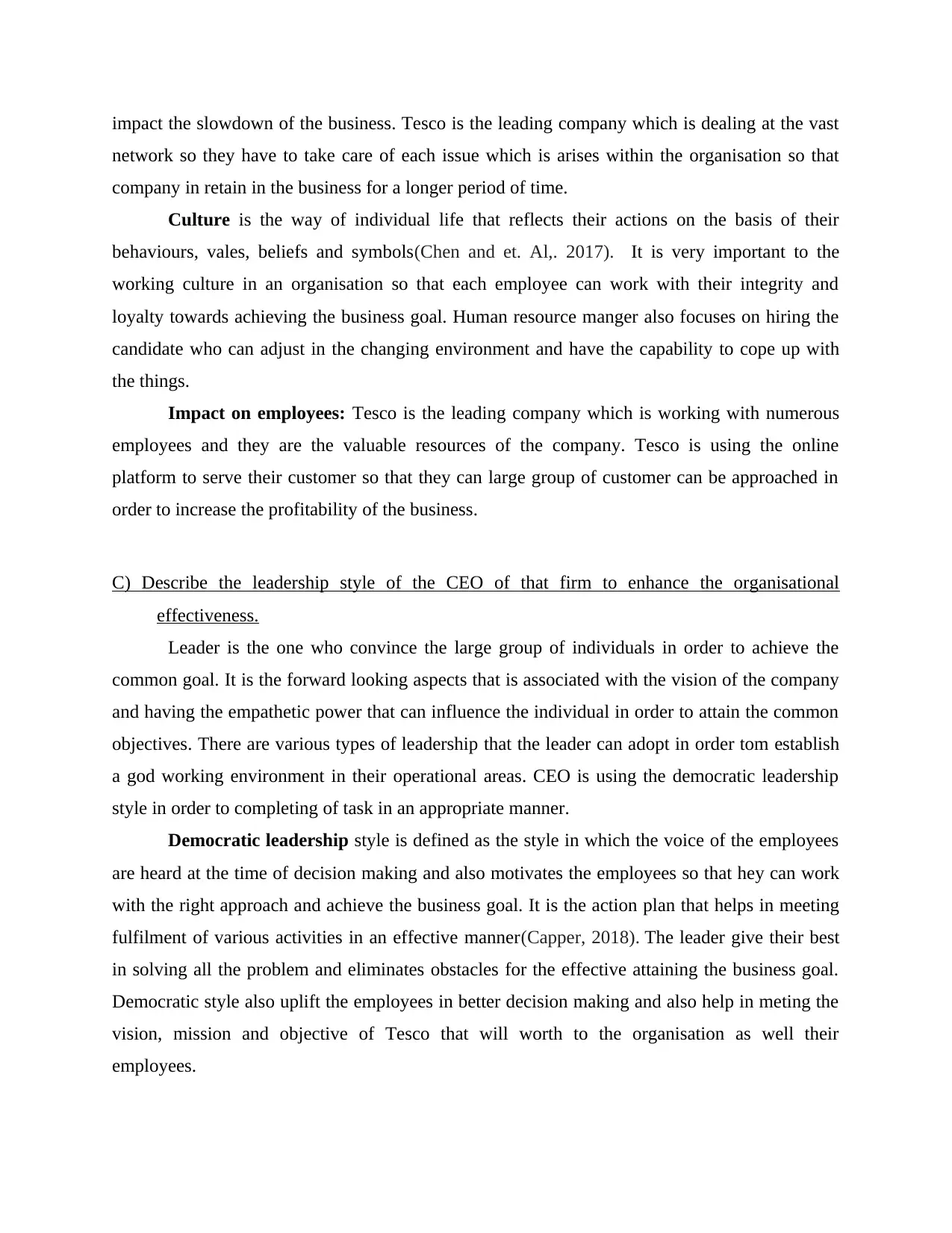
impact the slowdown of the business. Tesco is the leading company which is dealing at the vast
network so they have to take care of each issue which is arises within the organisation so that
company in retain in the business for a longer period of time.
Culture is the way of individual life that reflects their actions on the basis of their
behaviours, vales, beliefs and symbols(Chen and et. Al,. 2017). It is very important to the
working culture in an organisation so that each employee can work with their integrity and
loyalty towards achieving the business goal. Human resource manger also focuses on hiring the
candidate who can adjust in the changing environment and have the capability to cope up with
the things.
Impact on employees: Tesco is the leading company which is working with numerous
employees and they are the valuable resources of the company. Tesco is using the online
platform to serve their customer so that they can large group of customer can be approached in
order to increase the profitability of the business.
C) Describe the leadership style of the CEO of that firm to enhance the organisational
effectiveness.
Leader is the one who convince the large group of individuals in order to achieve the
common goal. It is the forward looking aspects that is associated with the vision of the company
and having the empathetic power that can influence the individual in order to attain the common
objectives. There are various types of leadership that the leader can adopt in order tom establish
a god working environment in their operational areas. CEO is using the democratic leadership
style in order to completing of task in an appropriate manner.
Democratic leadership style is defined as the style in which the voice of the employees
are heard at the time of decision making and also motivates the employees so that hey can work
with the right approach and achieve the business goal. It is the action plan that helps in meeting
fulfilment of various activities in an effective manner(Capper, 2018). The leader give their best
in solving all the problem and eliminates obstacles for the effective attaining the business goal.
Democratic style also uplift the employees in better decision making and also help in meting the
vision, mission and objective of Tesco that will worth to the organisation as well their
employees.
network so they have to take care of each issue which is arises within the organisation so that
company in retain in the business for a longer period of time.
Culture is the way of individual life that reflects their actions on the basis of their
behaviours, vales, beliefs and symbols(Chen and et. Al,. 2017). It is very important to the
working culture in an organisation so that each employee can work with their integrity and
loyalty towards achieving the business goal. Human resource manger also focuses on hiring the
candidate who can adjust in the changing environment and have the capability to cope up with
the things.
Impact on employees: Tesco is the leading company which is working with numerous
employees and they are the valuable resources of the company. Tesco is using the online
platform to serve their customer so that they can large group of customer can be approached in
order to increase the profitability of the business.
C) Describe the leadership style of the CEO of that firm to enhance the organisational
effectiveness.
Leader is the one who convince the large group of individuals in order to achieve the
common goal. It is the forward looking aspects that is associated with the vision of the company
and having the empathetic power that can influence the individual in order to attain the common
objectives. There are various types of leadership that the leader can adopt in order tom establish
a god working environment in their operational areas. CEO is using the democratic leadership
style in order to completing of task in an appropriate manner.
Democratic leadership style is defined as the style in which the voice of the employees
are heard at the time of decision making and also motivates the employees so that hey can work
with the right approach and achieve the business goal. It is the action plan that helps in meeting
fulfilment of various activities in an effective manner(Capper, 2018). The leader give their best
in solving all the problem and eliminates obstacles for the effective attaining the business goal.
Democratic style also uplift the employees in better decision making and also help in meting the
vision, mission and objective of Tesco that will worth to the organisation as well their
employees.
⊘ This is a preview!⊘
Do you want full access?
Subscribe today to unlock all pages.

Trusted by 1+ million students worldwide
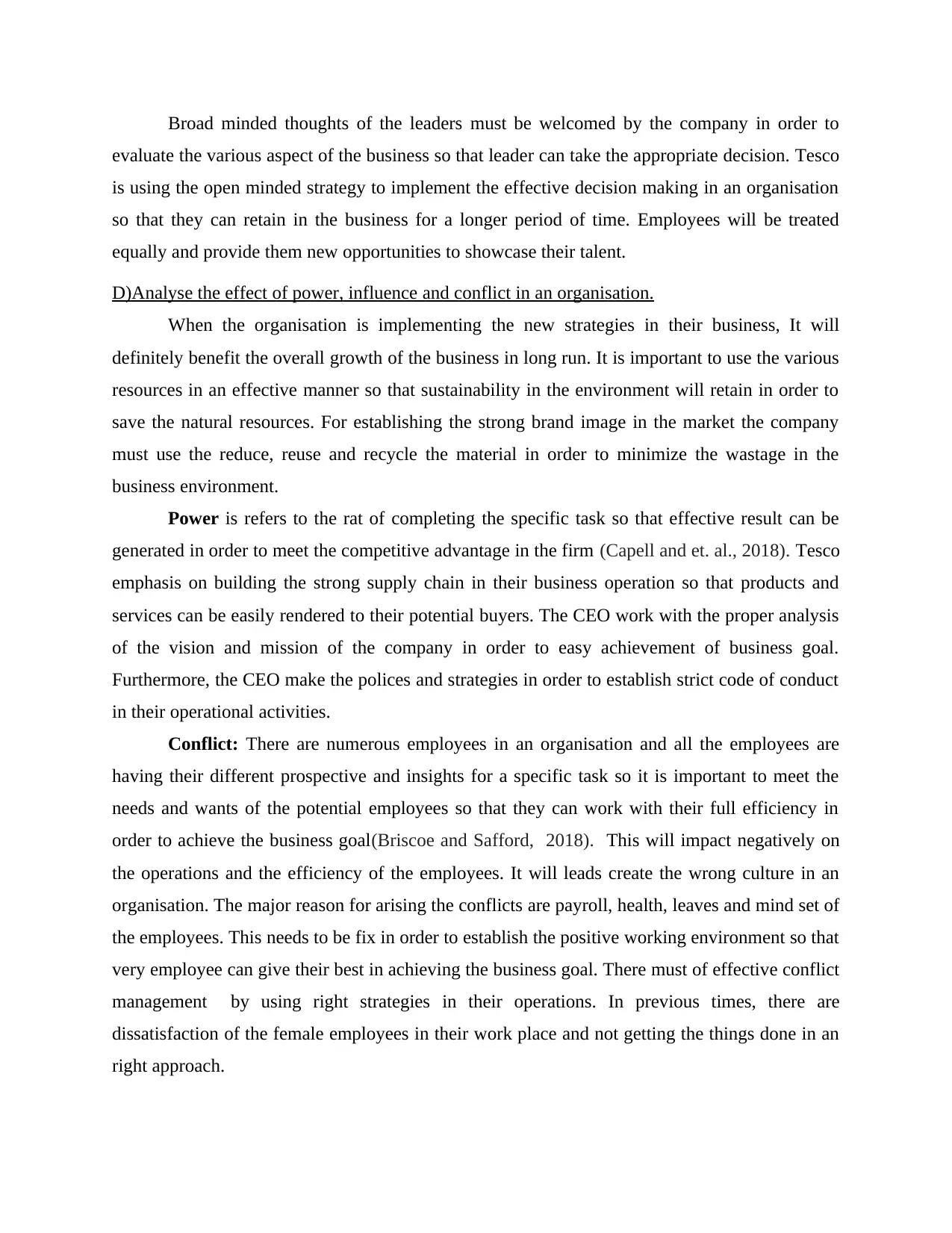
Broad minded thoughts of the leaders must be welcomed by the company in order to
evaluate the various aspect of the business so that leader can take the appropriate decision. Tesco
is using the open minded strategy to implement the effective decision making in an organisation
so that they can retain in the business for a longer period of time. Employees will be treated
equally and provide them new opportunities to showcase their talent.
D)Analyse the effect of power, influence and conflict in an organisation.
When the organisation is implementing the new strategies in their business, It will
definitely benefit the overall growth of the business in long run. It is important to use the various
resources in an effective manner so that sustainability in the environment will retain in order to
save the natural resources. For establishing the strong brand image in the market the company
must use the reduce, reuse and recycle the material in order to minimize the wastage in the
business environment.
Power is refers to the rat of completing the specific task so that effective result can be
generated in order to meet the competitive advantage in the firm (Capell and et. al., 2018). Tesco
emphasis on building the strong supply chain in their business operation so that products and
services can be easily rendered to their potential buyers. The CEO work with the proper analysis
of the vision and mission of the company in order to easy achievement of business goal.
Furthermore, the CEO make the polices and strategies in order to establish strict code of conduct
in their operational activities.
Conflict: There are numerous employees in an organisation and all the employees are
having their different prospective and insights for a specific task so it is important to meet the
needs and wants of the potential employees so that they can work with their full efficiency in
order to achieve the business goal(Briscoe and Safford, 2018). This will impact negatively on
the operations and the efficiency of the employees. It will leads create the wrong culture in an
organisation. The major reason for arising the conflicts are payroll, health, leaves and mind set of
the employees. This needs to be fix in order to establish the positive working environment so that
very employee can give their best in achieving the business goal. There must of effective conflict
management by using right strategies in their operations. In previous times, there are
dissatisfaction of the female employees in their work place and not getting the things done in an
right approach.
evaluate the various aspect of the business so that leader can take the appropriate decision. Tesco
is using the open minded strategy to implement the effective decision making in an organisation
so that they can retain in the business for a longer period of time. Employees will be treated
equally and provide them new opportunities to showcase their talent.
D)Analyse the effect of power, influence and conflict in an organisation.
When the organisation is implementing the new strategies in their business, It will
definitely benefit the overall growth of the business in long run. It is important to use the various
resources in an effective manner so that sustainability in the environment will retain in order to
save the natural resources. For establishing the strong brand image in the market the company
must use the reduce, reuse and recycle the material in order to minimize the wastage in the
business environment.
Power is refers to the rat of completing the specific task so that effective result can be
generated in order to meet the competitive advantage in the firm (Capell and et. al., 2018). Tesco
emphasis on building the strong supply chain in their business operation so that products and
services can be easily rendered to their potential buyers. The CEO work with the proper analysis
of the vision and mission of the company in order to easy achievement of business goal.
Furthermore, the CEO make the polices and strategies in order to establish strict code of conduct
in their operational activities.
Conflict: There are numerous employees in an organisation and all the employees are
having their different prospective and insights for a specific task so it is important to meet the
needs and wants of the potential employees so that they can work with their full efficiency in
order to achieve the business goal(Briscoe and Safford, 2018). This will impact negatively on
the operations and the efficiency of the employees. It will leads create the wrong culture in an
organisation. The major reason for arising the conflicts are payroll, health, leaves and mind set of
the employees. This needs to be fix in order to establish the positive working environment so that
very employee can give their best in achieving the business goal. There must of effective conflict
management by using right strategies in their operations. In previous times, there are
dissatisfaction of the female employees in their work place and not getting the things done in an
right approach.
Paraphrase This Document
Need a fresh take? Get an instant paraphrase of this document with our AI Paraphraser
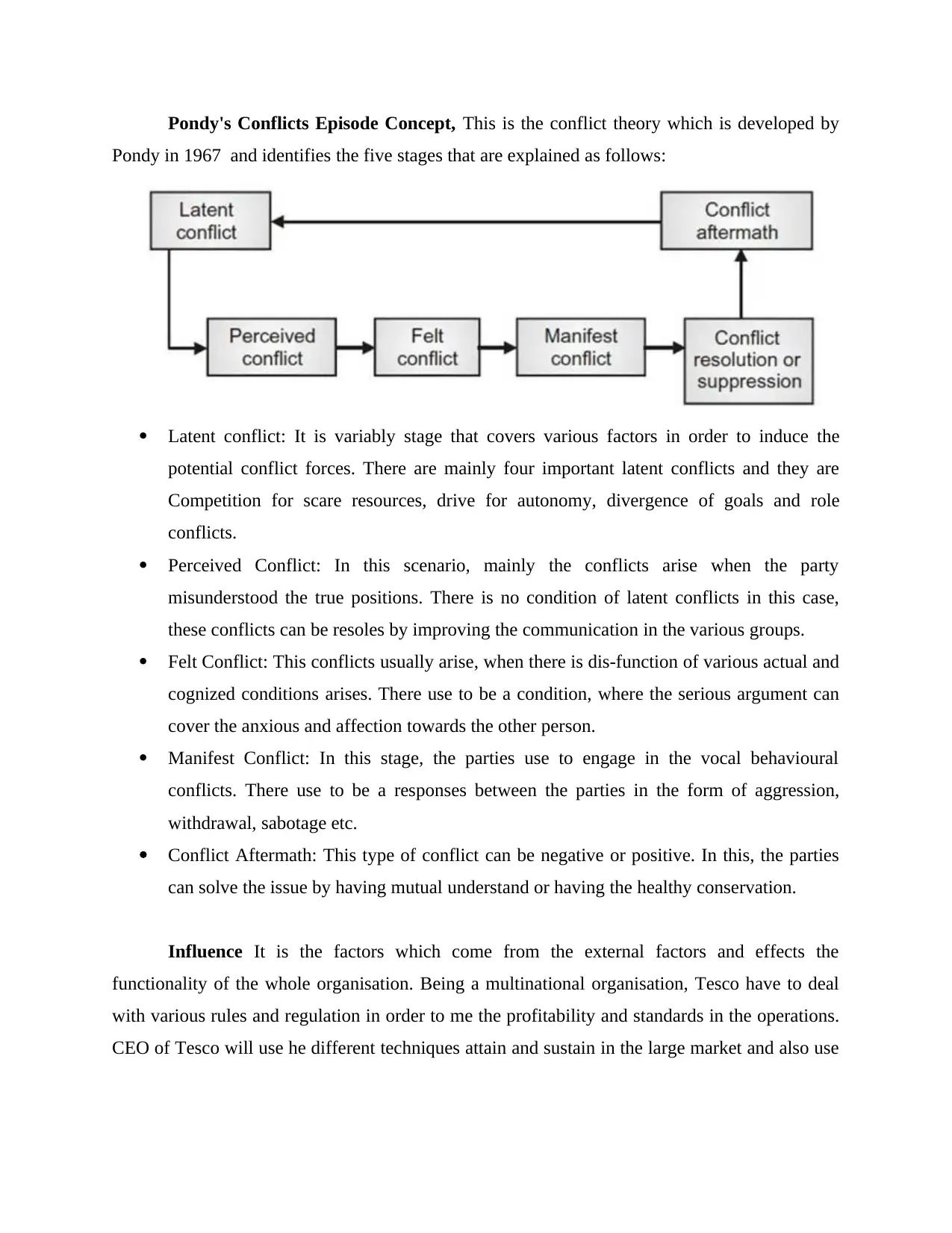
Pondy's Conflicts Episode Concept, This is the conflict theory which is developed by
Pondy in 1967 and identifies the five stages that are explained as follows:
Latent conflict: It is variably stage that covers various factors in order to induce the
potential conflict forces. There are mainly four important latent conflicts and they are
Competition for scare resources, drive for autonomy, divergence of goals and role
conflicts.
Perceived Conflict: In this scenario, mainly the conflicts arise when the party
misunderstood the true positions. There is no condition of latent conflicts in this case,
these conflicts can be resoles by improving the communication in the various groups.
Felt Conflict: This conflicts usually arise, when there is dis-function of various actual and
cognized conditions arises. There use to be a condition, where the serious argument can
cover the anxious and affection towards the other person.
Manifest Conflict: In this stage, the parties use to engage in the vocal behavioural
conflicts. There use to be a responses between the parties in the form of aggression,
withdrawal, sabotage etc.
Conflict Aftermath: This type of conflict can be negative or positive. In this, the parties
can solve the issue by having mutual understand or having the healthy conservation.
Influence It is the factors which come from the external factors and effects the
functionality of the whole organisation. Being a multinational organisation, Tesco have to deal
with various rules and regulation in order to me the profitability and standards in the operations.
CEO of Tesco will use he different techniques attain and sustain in the large market and also use
Pondy in 1967 and identifies the five stages that are explained as follows:
Latent conflict: It is variably stage that covers various factors in order to induce the
potential conflict forces. There are mainly four important latent conflicts and they are
Competition for scare resources, drive for autonomy, divergence of goals and role
conflicts.
Perceived Conflict: In this scenario, mainly the conflicts arise when the party
misunderstood the true positions. There is no condition of latent conflicts in this case,
these conflicts can be resoles by improving the communication in the various groups.
Felt Conflict: This conflicts usually arise, when there is dis-function of various actual and
cognized conditions arises. There use to be a condition, where the serious argument can
cover the anxious and affection towards the other person.
Manifest Conflict: In this stage, the parties use to engage in the vocal behavioural
conflicts. There use to be a responses between the parties in the form of aggression,
withdrawal, sabotage etc.
Conflict Aftermath: This type of conflict can be negative or positive. In this, the parties
can solve the issue by having mutual understand or having the healthy conservation.
Influence It is the factors which come from the external factors and effects the
functionality of the whole organisation. Being a multinational organisation, Tesco have to deal
with various rules and regulation in order to me the profitability and standards in the operations.
CEO of Tesco will use he different techniques attain and sustain in the large market and also use
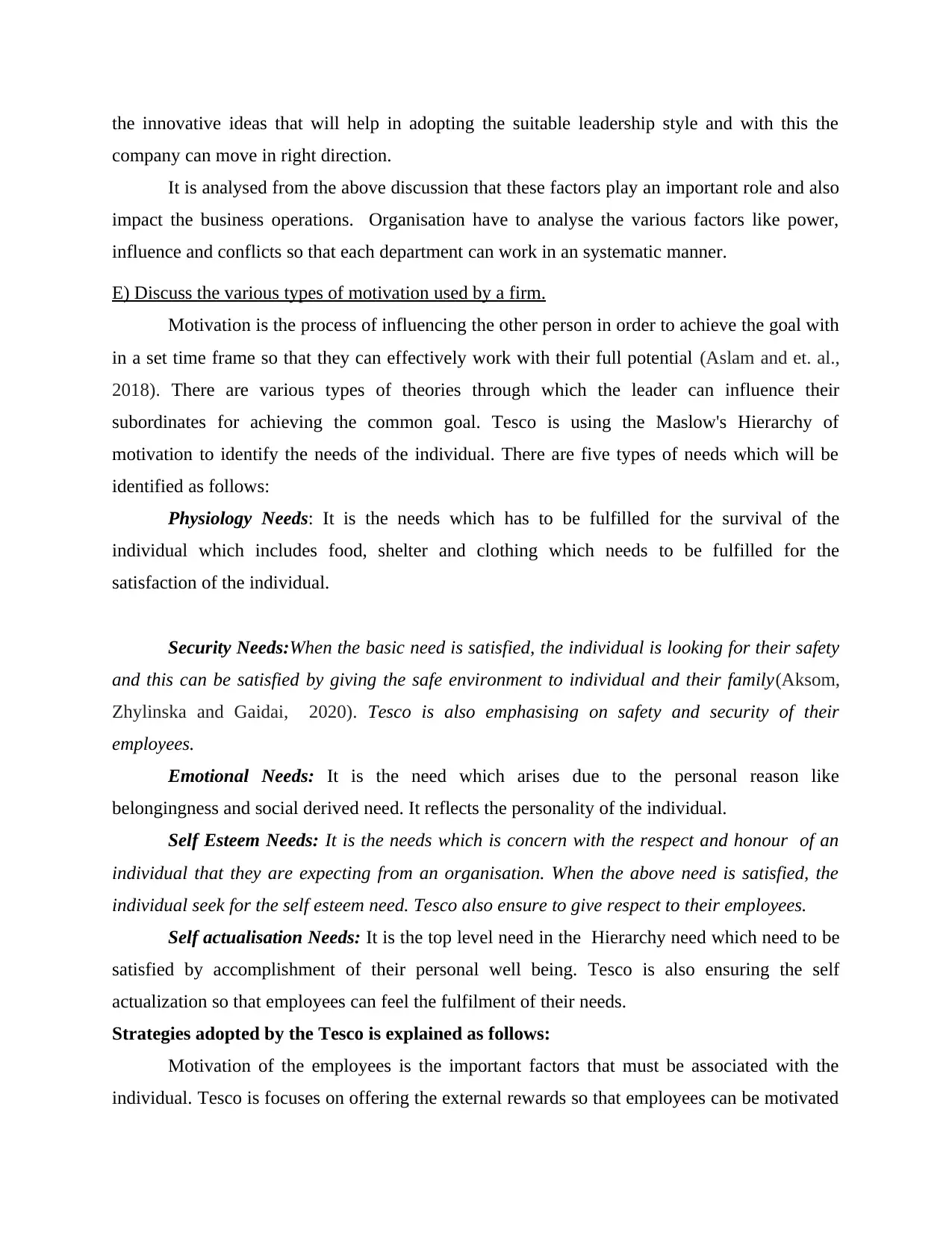
the innovative ideas that will help in adopting the suitable leadership style and with this the
company can move in right direction.
It is analysed from the above discussion that these factors play an important role and also
impact the business operations. Organisation have to analyse the various factors like power,
influence and conflicts so that each department can work in an systematic manner.
E) Discuss the various types of motivation used by a firm.
Motivation is the process of influencing the other person in order to achieve the goal with
in a set time frame so that they can effectively work with their full potential (Aslam and et. al.,
2018). There are various types of theories through which the leader can influence their
subordinates for achieving the common goal. Tesco is using the Maslow's Hierarchy of
motivation to identify the needs of the individual. There are five types of needs which will be
identified as follows:
Physiology Needs: It is the needs which has to be fulfilled for the survival of the
individual which includes food, shelter and clothing which needs to be fulfilled for the
satisfaction of the individual.
Security Needs:When the basic need is satisfied, the individual is looking for their safety
and this can be satisfied by giving the safe environment to individual and their family(Aksom,
Zhylinska and Gaidai, 2020). Tesco is also emphasising on safety and security of their
employees.
Emotional Needs: It is the need which arises due to the personal reason like
belongingness and social derived need. It reflects the personality of the individual.
Self Esteem Needs: It is the needs which is concern with the respect and honour of an
individual that they are expecting from an organisation. When the above need is satisfied, the
individual seek for the self esteem need. Tesco also ensure to give respect to their employees.
Self actualisation Needs: It is the top level need in the Hierarchy need which need to be
satisfied by accomplishment of their personal well being. Tesco is also ensuring the self
actualization so that employees can feel the fulfilment of their needs.
Strategies adopted by the Tesco is explained as follows:
Motivation of the employees is the important factors that must be associated with the
individual. Tesco is focuses on offering the external rewards so that employees can be motivated
company can move in right direction.
It is analysed from the above discussion that these factors play an important role and also
impact the business operations. Organisation have to analyse the various factors like power,
influence and conflicts so that each department can work in an systematic manner.
E) Discuss the various types of motivation used by a firm.
Motivation is the process of influencing the other person in order to achieve the goal with
in a set time frame so that they can effectively work with their full potential (Aslam and et. al.,
2018). There are various types of theories through which the leader can influence their
subordinates for achieving the common goal. Tesco is using the Maslow's Hierarchy of
motivation to identify the needs of the individual. There are five types of needs which will be
identified as follows:
Physiology Needs: It is the needs which has to be fulfilled for the survival of the
individual which includes food, shelter and clothing which needs to be fulfilled for the
satisfaction of the individual.
Security Needs:When the basic need is satisfied, the individual is looking for their safety
and this can be satisfied by giving the safe environment to individual and their family(Aksom,
Zhylinska and Gaidai, 2020). Tesco is also emphasising on safety and security of their
employees.
Emotional Needs: It is the need which arises due to the personal reason like
belongingness and social derived need. It reflects the personality of the individual.
Self Esteem Needs: It is the needs which is concern with the respect and honour of an
individual that they are expecting from an organisation. When the above need is satisfied, the
individual seek for the self esteem need. Tesco also ensure to give respect to their employees.
Self actualisation Needs: It is the top level need in the Hierarchy need which need to be
satisfied by accomplishment of their personal well being. Tesco is also ensuring the self
actualization so that employees can feel the fulfilment of their needs.
Strategies adopted by the Tesco is explained as follows:
Motivation of the employees is the important factors that must be associated with the
individual. Tesco is focuses on offering the external rewards so that employees can be motivated
⊘ This is a preview!⊘
Do you want full access?
Subscribe today to unlock all pages.

Trusted by 1+ million students worldwide
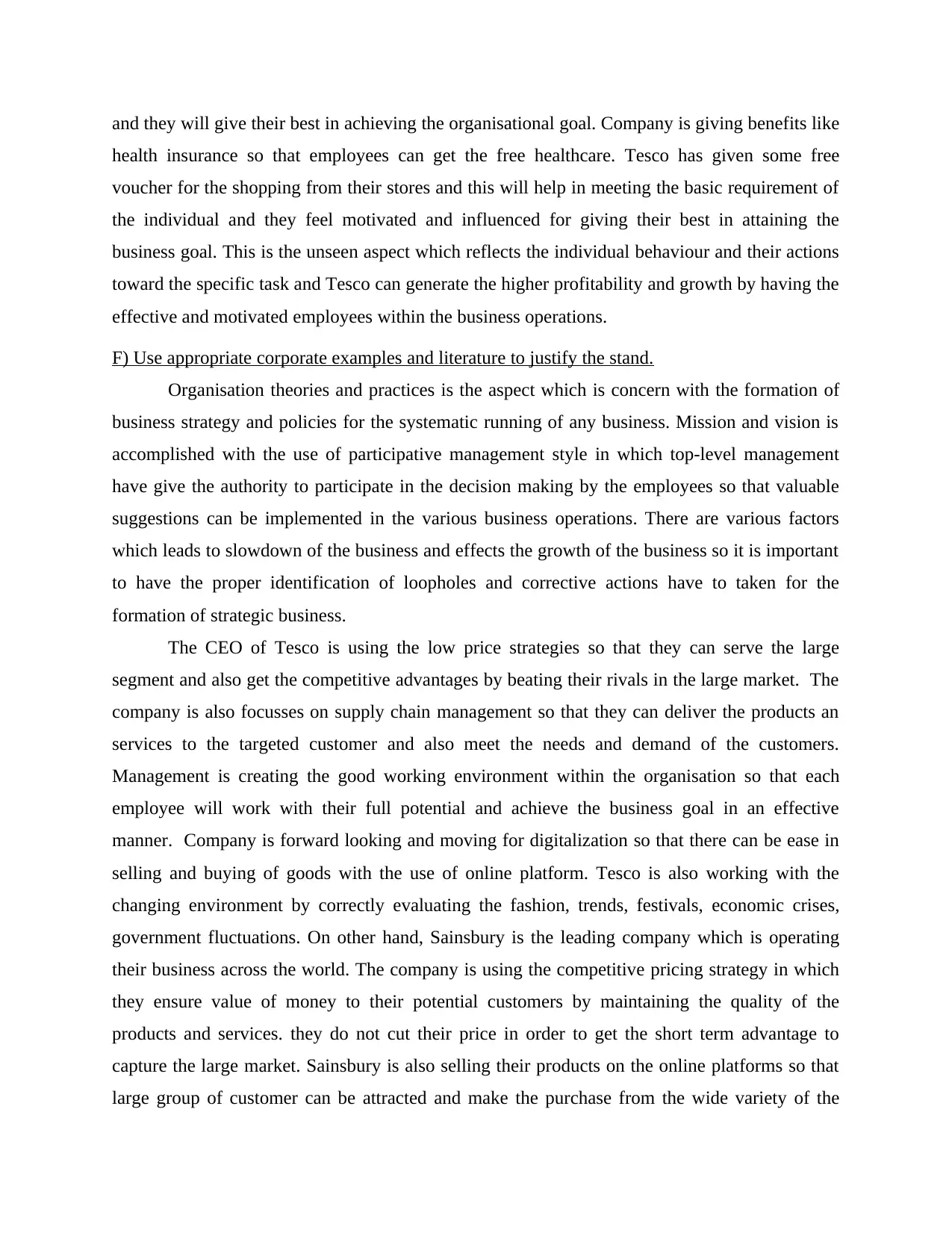
and they will give their best in achieving the organisational goal. Company is giving benefits like
health insurance so that employees can get the free healthcare. Tesco has given some free
voucher for the shopping from their stores and this will help in meeting the basic requirement of
the individual and they feel motivated and influenced for giving their best in attaining the
business goal. This is the unseen aspect which reflects the individual behaviour and their actions
toward the specific task and Tesco can generate the higher profitability and growth by having the
effective and motivated employees within the business operations.
F) Use appropriate corporate examples and literature to justify the stand.
Organisation theories and practices is the aspect which is concern with the formation of
business strategy and policies for the systematic running of any business. Mission and vision is
accomplished with the use of participative management style in which top-level management
have give the authority to participate in the decision making by the employees so that valuable
suggestions can be implemented in the various business operations. There are various factors
which leads to slowdown of the business and effects the growth of the business so it is important
to have the proper identification of loopholes and corrective actions have to taken for the
formation of strategic business.
The CEO of Tesco is using the low price strategies so that they can serve the large
segment and also get the competitive advantages by beating their rivals in the large market. The
company is also focusses on supply chain management so that they can deliver the products an
services to the targeted customer and also meet the needs and demand of the customers.
Management is creating the good working environment within the organisation so that each
employee will work with their full potential and achieve the business goal in an effective
manner. Company is forward looking and moving for digitalization so that there can be ease in
selling and buying of goods with the use of online platform. Tesco is also working with the
changing environment by correctly evaluating the fashion, trends, festivals, economic crises,
government fluctuations. On other hand, Sainsbury is the leading company which is operating
their business across the world. The company is using the competitive pricing strategy in which
they ensure value of money to their potential customers by maintaining the quality of the
products and services. they do not cut their price in order to get the short term advantage to
capture the large market. Sainsbury is also selling their products on the online platforms so that
large group of customer can be attracted and make the purchase from the wide variety of the
health insurance so that employees can get the free healthcare. Tesco has given some free
voucher for the shopping from their stores and this will help in meeting the basic requirement of
the individual and they feel motivated and influenced for giving their best in attaining the
business goal. This is the unseen aspect which reflects the individual behaviour and their actions
toward the specific task and Tesco can generate the higher profitability and growth by having the
effective and motivated employees within the business operations.
F) Use appropriate corporate examples and literature to justify the stand.
Organisation theories and practices is the aspect which is concern with the formation of
business strategy and policies for the systematic running of any business. Mission and vision is
accomplished with the use of participative management style in which top-level management
have give the authority to participate in the decision making by the employees so that valuable
suggestions can be implemented in the various business operations. There are various factors
which leads to slowdown of the business and effects the growth of the business so it is important
to have the proper identification of loopholes and corrective actions have to taken for the
formation of strategic business.
The CEO of Tesco is using the low price strategies so that they can serve the large
segment and also get the competitive advantages by beating their rivals in the large market. The
company is also focusses on supply chain management so that they can deliver the products an
services to the targeted customer and also meet the needs and demand of the customers.
Management is creating the good working environment within the organisation so that each
employee will work with their full potential and achieve the business goal in an effective
manner. Company is forward looking and moving for digitalization so that there can be ease in
selling and buying of goods with the use of online platform. Tesco is also working with the
changing environment by correctly evaluating the fashion, trends, festivals, economic crises,
government fluctuations. On other hand, Sainsbury is the leading company which is operating
their business across the world. The company is using the competitive pricing strategy in which
they ensure value of money to their potential customers by maintaining the quality of the
products and services. they do not cut their price in order to get the short term advantage to
capture the large market. Sainsbury is also selling their products on the online platforms so that
large group of customer can be attracted and make the purchase from the wide variety of the
Paraphrase This Document
Need a fresh take? Get an instant paraphrase of this document with our AI Paraphraser
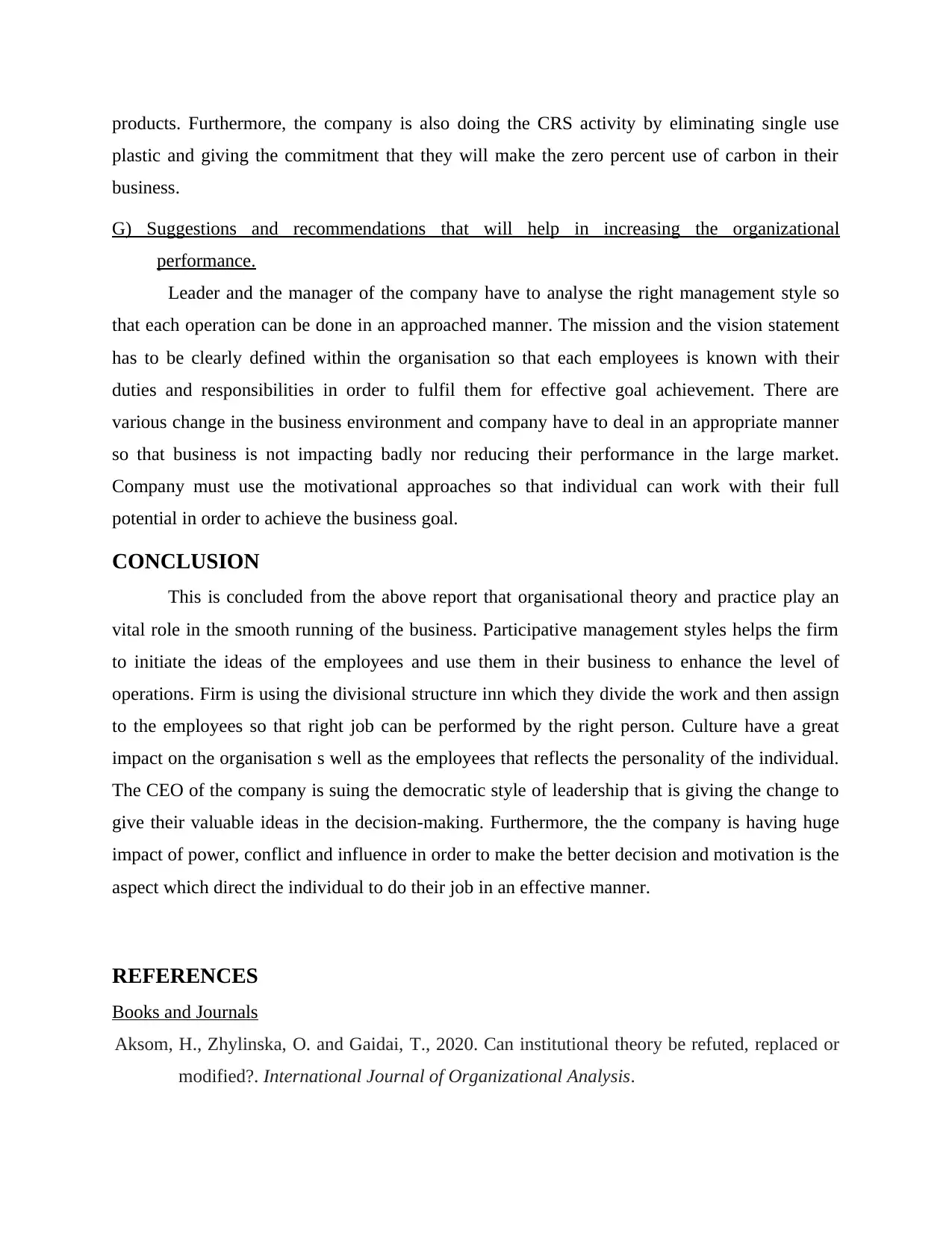
products. Furthermore, the company is also doing the CRS activity by eliminating single use
plastic and giving the commitment that they will make the zero percent use of carbon in their
business.
G) Suggestions and recommendations that will help in increasing the organizational
performance.
Leader and the manager of the company have to analyse the right management style so
that each operation can be done in an approached manner. The mission and the vision statement
has to be clearly defined within the organisation so that each employees is known with their
duties and responsibilities in order to fulfil them for effective goal achievement. There are
various change in the business environment and company have to deal in an appropriate manner
so that business is not impacting badly nor reducing their performance in the large market.
Company must use the motivational approaches so that individual can work with their full
potential in order to achieve the business goal.
CONCLUSION
This is concluded from the above report that organisational theory and practice play an
vital role in the smooth running of the business. Participative management styles helps the firm
to initiate the ideas of the employees and use them in their business to enhance the level of
operations. Firm is using the divisional structure inn which they divide the work and then assign
to the employees so that right job can be performed by the right person. Culture have a great
impact on the organisation s well as the employees that reflects the personality of the individual.
The CEO of the company is suing the democratic style of leadership that is giving the change to
give their valuable ideas in the decision-making. Furthermore, the the company is having huge
impact of power, conflict and influence in order to make the better decision and motivation is the
aspect which direct the individual to do their job in an effective manner.
REFERENCES
Books and Journals
Aksom, H., Zhylinska, O. and Gaidai, T., 2020. Can institutional theory be refuted, replaced or
modified?. International Journal of Organizational Analysis.
plastic and giving the commitment that they will make the zero percent use of carbon in their
business.
G) Suggestions and recommendations that will help in increasing the organizational
performance.
Leader and the manager of the company have to analyse the right management style so
that each operation can be done in an approached manner. The mission and the vision statement
has to be clearly defined within the organisation so that each employees is known with their
duties and responsibilities in order to fulfil them for effective goal achievement. There are
various change in the business environment and company have to deal in an appropriate manner
so that business is not impacting badly nor reducing their performance in the large market.
Company must use the motivational approaches so that individual can work with their full
potential in order to achieve the business goal.
CONCLUSION
This is concluded from the above report that organisational theory and practice play an
vital role in the smooth running of the business. Participative management styles helps the firm
to initiate the ideas of the employees and use them in their business to enhance the level of
operations. Firm is using the divisional structure inn which they divide the work and then assign
to the employees so that right job can be performed by the right person. Culture have a great
impact on the organisation s well as the employees that reflects the personality of the individual.
The CEO of the company is suing the democratic style of leadership that is giving the change to
give their valuable ideas in the decision-making. Furthermore, the the company is having huge
impact of power, conflict and influence in order to make the better decision and motivation is the
aspect which direct the individual to do their job in an effective manner.
REFERENCES
Books and Journals
Aksom, H., Zhylinska, O. and Gaidai, T., 2020. Can institutional theory be refuted, replaced or
modified?. International Journal of Organizational Analysis.
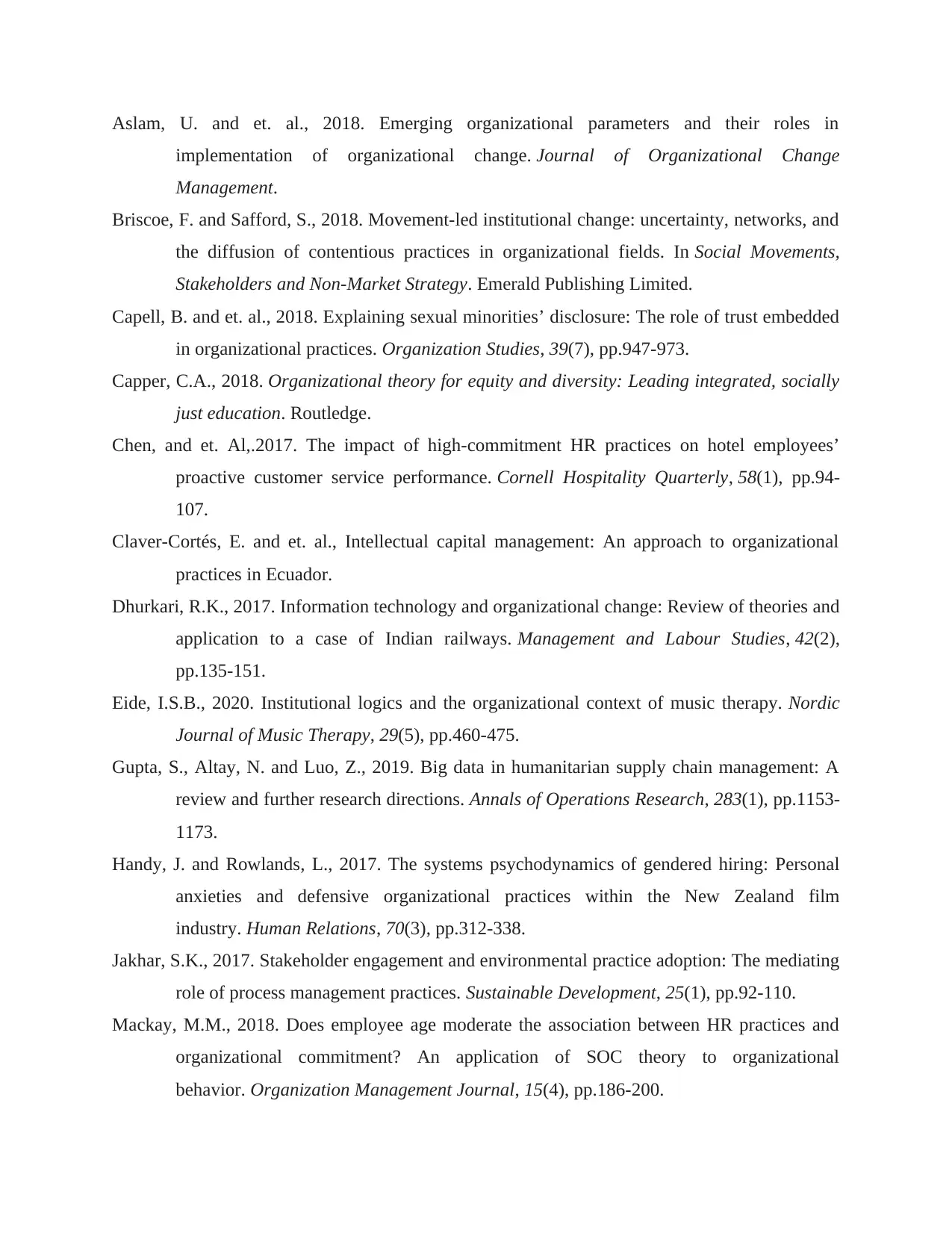
Aslam, U. and et. al., 2018. Emerging organizational parameters and their roles in
implementation of organizational change. Journal of Organizational Change
Management.
Briscoe, F. and Safford, S., 2018. Movement-led institutional change: uncertainty, networks, and
the diffusion of contentious practices in organizational fields. In Social Movements,
Stakeholders and Non-Market Strategy. Emerald Publishing Limited.
Capell, B. and et. al., 2018. Explaining sexual minorities’ disclosure: The role of trust embedded
in organizational practices. Organization Studies, 39(7), pp.947-973.
Capper, C.A., 2018. Organizational theory for equity and diversity: Leading integrated, socially
just education. Routledge.
Chen, and et. Al,.2017. The impact of high-commitment HR practices on hotel employees’
proactive customer service performance. Cornell Hospitality Quarterly, 58(1), pp.94-
107.
Claver-Cortés, E. and et. al., Intellectual capital management: An approach to organizational
practices in Ecuador.
Dhurkari, R.K., 2017. Information technology and organizational change: Review of theories and
application to a case of Indian railways. Management and Labour Studies, 42(2),
pp.135-151.
Eide, I.S.B., 2020. Institutional logics and the organizational context of music therapy. Nordic
Journal of Music Therapy, 29(5), pp.460-475.
Gupta, S., Altay, N. and Luo, Z., 2019. Big data in humanitarian supply chain management: A
review and further research directions. Annals of Operations Research, 283(1), pp.1153-
1173.
Handy, J. and Rowlands, L., 2017. The systems psychodynamics of gendered hiring: Personal
anxieties and defensive organizational practices within the New Zealand film
industry. Human Relations, 70(3), pp.312-338.
Jakhar, S.K., 2017. Stakeholder engagement and environmental practice adoption: The mediating
role of process management practices. Sustainable Development, 25(1), pp.92-110.
Mackay, M.M., 2018. Does employee age moderate the association between HR practices and
organizational commitment? An application of SOC theory to organizational
behavior. Organization Management Journal, 15(4), pp.186-200.
implementation of organizational change. Journal of Organizational Change
Management.
Briscoe, F. and Safford, S., 2018. Movement-led institutional change: uncertainty, networks, and
the diffusion of contentious practices in organizational fields. In Social Movements,
Stakeholders and Non-Market Strategy. Emerald Publishing Limited.
Capell, B. and et. al., 2018. Explaining sexual minorities’ disclosure: The role of trust embedded
in organizational practices. Organization Studies, 39(7), pp.947-973.
Capper, C.A., 2018. Organizational theory for equity and diversity: Leading integrated, socially
just education. Routledge.
Chen, and et. Al,.2017. The impact of high-commitment HR practices on hotel employees’
proactive customer service performance. Cornell Hospitality Quarterly, 58(1), pp.94-
107.
Claver-Cortés, E. and et. al., Intellectual capital management: An approach to organizational
practices in Ecuador.
Dhurkari, R.K., 2017. Information technology and organizational change: Review of theories and
application to a case of Indian railways. Management and Labour Studies, 42(2),
pp.135-151.
Eide, I.S.B., 2020. Institutional logics and the organizational context of music therapy. Nordic
Journal of Music Therapy, 29(5), pp.460-475.
Gupta, S., Altay, N. and Luo, Z., 2019. Big data in humanitarian supply chain management: A
review and further research directions. Annals of Operations Research, 283(1), pp.1153-
1173.
Handy, J. and Rowlands, L., 2017. The systems psychodynamics of gendered hiring: Personal
anxieties and defensive organizational practices within the New Zealand film
industry. Human Relations, 70(3), pp.312-338.
Jakhar, S.K., 2017. Stakeholder engagement and environmental practice adoption: The mediating
role of process management practices. Sustainable Development, 25(1), pp.92-110.
Mackay, M.M., 2018. Does employee age moderate the association between HR practices and
organizational commitment? An application of SOC theory to organizational
behavior. Organization Management Journal, 15(4), pp.186-200.
⊘ This is a preview!⊘
Do you want full access?
Subscribe today to unlock all pages.

Trusted by 1+ million students worldwide
1 out of 13
Related Documents
Your All-in-One AI-Powered Toolkit for Academic Success.
+13062052269
info@desklib.com
Available 24*7 on WhatsApp / Email
![[object Object]](/_next/static/media/star-bottom.7253800d.svg)
Unlock your academic potential
Copyright © 2020–2025 A2Z Services. All Rights Reserved. Developed and managed by ZUCOL.





